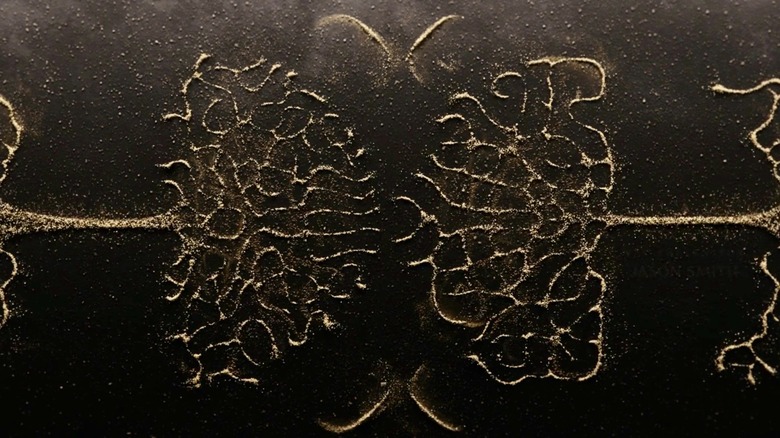The Shapes In The Opening Credits Of The Rings Of Power Have An Important Meaning
"The Lord of the Rings: The Rings of Power" takes a rather abstract approach to its opening credits, but there was a lot of thought put into the symbolism behind it. Over about a minute and a half each week, we hear Howard Shore's opening theme for "The Rings of Power" and see formations of sand coming together. They break apart just as quickly, and though the shapes aren't always circular and the designs are less colorful, they almost bring to mind mandalas, geometric figures used in Eastern religions for meditation. Netflix's "House of Cards," for example, once featured Tibetan monks crafting an intricate sand mandala in the White House, only for them to brush it all away at the end of the episode, as if to show the transient beauty of life.
"The Rings of Power" drew inspiration from an altogether different source for its opening credits. A recent Twitter thread from game designer Alexander King noted the similarities between the show's opening sand formations and Chladni figures, named for the German musician and "father of acoustics," Ernst Chladni, who studied the effects of resonance on rigid surfaces. He discovered that by running a violin bow along a plate, it would cause the sand on top of it to vibrate along "nodal lines" and form noticeable patterns.
"In [J.R.R.] Tolkien's legendarium," King observes, "the creator god Ilúvatar sort of creates the world out of music. The beauty of these figures is just a physical manifestation of the harmony of the 'Music of the Ainur'," or Holy Ones, angelic beings who existed before the creation of Middle-earth.
This thread subsequently drew the attention of creative director Anthony Vitagliano, who is part of the team that designed the opening credits for "The Rings of Power."
'Fleeting visions of conflict and harmony'
Vitagliano linked to Plains to Yonder, the film studio and creative consultancy that put together the opening titles for "The Rings of Power." The studio's website confirms that, "taking inspiration from J.R.R. Tolkien's Ainur, immortal angelic beings that sing such beautiful music that the world is created from their very sound, we conceived of a main title sequence 'built from the world of sound.'"
The site goes on to talk about cymatics, the "natural phenomenon that makes sound visible to the eye" and causes "striking symmetrical patterns" to form when "fine particles on a flat surface" vibrate. It doesn't have to be sand; Chladni was building off the research of polymath Robert Hooke, who used flour in his experiments.
Suffice it to say, "The Rings of Power" takes a bit of artistic license with this natural phenomenon and has the sand forming trees and ring shapes in its opening credits. At one point, we also see black sand mixing in with the golden particles like a snake or river of sludge. This goes along with the creative team's intent to convey how "the unknowable realms of sound create fleeting visions of conflict and harmony that move in lockstep with Howard Shores' opening title score."
Plains of Yonder notes that their work on "The Rings of Power" and its main title sequence "came together through a digitally connected caravan of creators that ran from Seattle to Chicago to London." You can see the full list of creators involved over on their website, and you can see "The Lord of the Rings: The Rings of Power" streaming exclusively on Prime Video.

